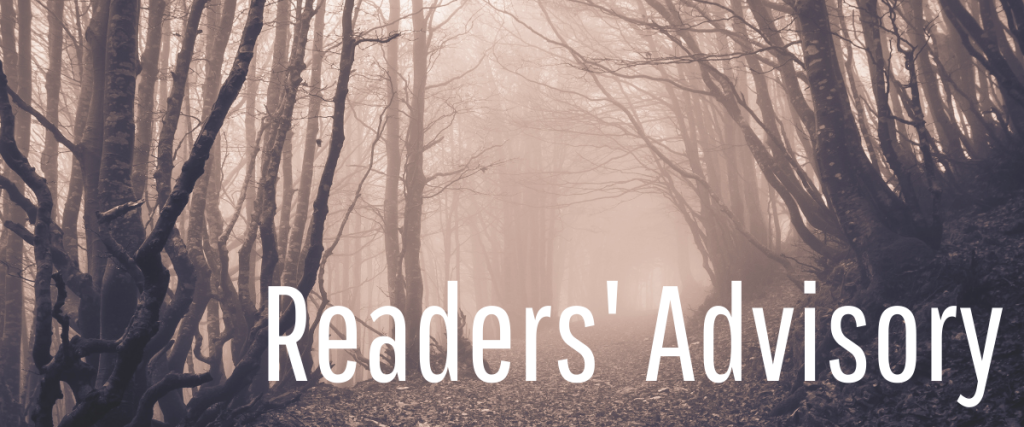Posts Tagged ‘Readers' Advisory’
Readers’ Advisory The Gothic Novel
Gothic novels have become some of the most well-known classics. But what sets a book apart from the horror genre as Gothic?
Like every genre of literature, horror novels can be broken down into many subgenres from paranormal, like The Exorcist by William Peter Blatty, to The Last Astronaut by David Wellington with its outer space setting and science fiction theme. But horror novels started long before Regan met Fathers Karras and Merrin when in 1764, Horace Walpole published The Castle of Otranto. This book created many of the elements of what would become known as the Gothic style of literature.
In Gothic novels, the setting tends to be an essential element of the story. Think dark, dreary, dripping
castles like the one where Jonathan Harker finds himself in Dracula. More recent Gothic novels like Catherine House by Elisabeth Thomas may be set in a modern-day boarding school. Still, the oppressive atmosphere of the buildings and ground is an essential element. Seclusion is crucial in the setting of the home as well. For example, traveling to Dracula’s castle can only be reached via a treacherous coach ride through the Carpathian mountains. While the Catherine House is merely at the end of a long driveway, it is still secluded deep in the Pennsylvania woods.
It is not always the physical building that needs to be dark and dreary to create the atmosphere necessary for a Gothic novel. Emily Bronte brought used weather in her novel Wuthering Heights to create a foreboding atmosphere. We also find many Gothic heroines forced into precarious circumstances by the weather. For example, after Jane leaves Thornfield Hall, a storm rises and blows her onto the doorstep of the Rivers siblings, who allow her to stay.
Exploring crumbling country homes while a thunderstorm rages outside is undoubtedly creepy. However, to reach the level of true Gothic horror, something needs to leap out from the shadows. Gothic novels lean heavily into the paranormal and supernatural elements when creating their villains, filling them with vampires, ghosts, and even manufactured monsters like Mr. Hyde. However, sometimes the monster making is out of our character’s control – the Castle of Otranto itself is under a prophecy that any family who owns it will meet tragic ends. The current lord, Manfred, is aware of this and goes to great lengths to preserve his lineage and slowly becomes the novel’s villain.
Gothic literature, like all literature, has evolved through the years. For example, in 2022, an abandoned mid-century home could create an atmosphere just as disheartening as the Halloran House in Shirley Jackson’s The Sundial and a Vacation. Likewise, no cellphone service would be as much of a deterrent as the wolves that attack Jonathan Harker’s coach as he makes his way to Count Dracula’s castle. But underneath all the changes, Gothic literature still contains several elements that send a shiver up our collective spines.
Black History Month 2022
Feb 1, 2022 – Mar 1, 2022
There are multiple ways to celebrate Black History Month with the Chickasha Public Library.
You can join the Black History Month 2022 Beanstack challenge. A description of the Beanstack challenge can be found below, along with a link to register.
Celebrate Black History Month! Learn about the history of Black health and wellness in the U.S. and explore mental, emotional, and physical health resources created by and for the Black community. For further reading, check out book recommendations honoring the Black experience. Log your reading and activities to earn badges all month long. Registration is now open.
You can also check out one of the books from our Black History Month display, and children can grab a free Black History Month take and make activity.
Library Displays
The library has a large and varied collection of materials for all ages. All of the items have been carefully selected with our community in mind. With such a large collection it is possible that some items may get overlooked. To prevent this staff creates displays to highlight unique items and subjects.
We often use an upcoming holiday as an inspiration for our displays. With the start of November, we have dedicated one area to items about Christmas. Some items have a plotline that centers around a Christmas celebration like The Christmas Pearl by Dorothea Benton Frank where Theodora gathers her family to her home in South Carolina or may just be set during the Christmas season as in Andrew Greeley’s Home for Christmas where Captain Kane struggles to return to his first love in time for the holiday.
As part of general collection development, we assess our current collection to determine if it needs an update. This summer we found a gap in the sports collection and decided to beef it up. This resulted in a large amount of items about sports being added so we chose to spotlight the new additions. Because the titles which included, Born on the Links: A Concise History of Golf by John Williamson where the author covers the timeline of golf from 15th century Scotland to today and the first full length biography of Harry Caray since his death in 1998,The Legendary Harry Caray: Baseball’s Greatest Salesman are shelved in the non-fiction section we were worried that these great reads would be missed by casual browsers we showcased these with a fun display on the front unit.
If you visited the library during 2020 while the library was limiting seating, you may have noticed that some of the tables had small displays on them. These were topics that we felt were interesting, but we just didn’t have enough items to fill a display shelf. We took the idea of a mini-display and created “Take 5” for the library catalog. Take 5 is a curated list of 5 items that the library owns and thinks customers may be interested in. You can view the weekly Take 5 and other curated lists here. Other lists you may find include books that complement other articles in the newsletter or honor literary occasions like Science Fiction Day on January 2 or Caldecott Day on June 14. The Caldecott Medal is awarded for the “most distinguished picture book for children” Past winners of this award include Jumanji by Chris Van Allsburg and This is Not my Hat by Jon Klassen.
Next time you come to the library be sure to check out the displays that we have created. You may just find a new favorite!



